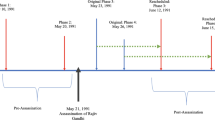Abstract
In order to have references for discussing mathematical menus in political science, I review the most common types of mathematical formulae used in physics and chemistry, as well as some mathematical advances in economics. Several issues appear relevant: variables should be well defined and measurable; the relationships between variables may be non-linear; the direction of causality should be clearly identified and not assumed on a priori grounds. On these bases, theoretically driven equations on political matters can be validated by empirical tests and can predict observable phenomena.

Similar content being viewed by others
References
Abramowitz, A.I. (2005) ‘The time-for-change model and the 2004 presidential election: a post-mortem and a look ahead’, PS: Political Science & Politics 38(1): 31.
Arrow, K. (1985) ‘Economic history: a necessary though not sufficient condition for an economist’, American Economic Review 75(2): 320–323.
Campbell, J.E. (2004) ‘Introduction’, PS: Political Science & Politics 37(4): 733–735.
Crease, R.P. (2004) ‘The greatest equations ever’, Physics World, 8(10): 19–23.
Farmelo, G. (ed.) (2002) It Must be Beautiful: Great Equations of Modern Science, New York: Granta Books.
Leigh, A. and Wolfers, J. (2006) Competing approaches to forecasting elections: economic models, opinion polling and prediction markets, NBER Working Paper No. 12053.
Lewis-Beck, M.S. and Tien, C. (2004) ‘Jobs and the job of president: a forecast for 2004’, PS: Political Science & Politics 37(4): 753–758.
Malinvaud, E. (1970) ‘The consistency of nonlinear regressions’, The Annals of Mathematical Statistics 41(3): 956–969.
McGregor, J.P. (1993) ‘Procrustus and the regression model: on the misuse of the regression model’, PS: Political Science & Politics 26(4): 801–804.
Prachowny, M.F.J. (1993) ‘Okun's law: theoretical foundations and revised estimates’, The Review of Economics and Statistics 75(2): 331–336.
Sargent, T.J. (1999) The Conquest of American Inflation, Princeton: Princeton University Press.
Author information
Authors and Affiliations
Corresponding author
Additional information
1I am very grateful to Rein Taagepera for pushing on this, as well as for fruitful exchanges with the other participants in the symposium at the ECPR Conference in Budapest, September 2005. I also acknowledge insightful hints made by José García-Montalvo, Ramon Marimon and Andreu Mas-Colell. The usual caveats regarding the author's sole responsibility apply, this time perhaps even more than usual.
Rights and permissions
About this article
Cite this article
Colomer, J. what other sciences look like. Eur Polit Sci 6, 134–142 (2007). https://doi.org/10.1057/palgrave.eps.2210119
Published:
Issue Date:
DOI: https://doi.org/10.1057/palgrave.eps.2210119




